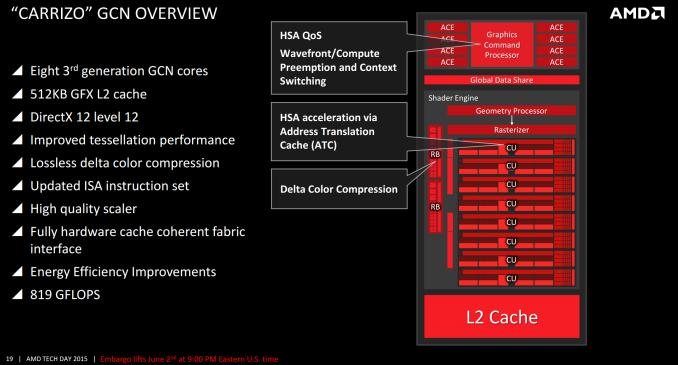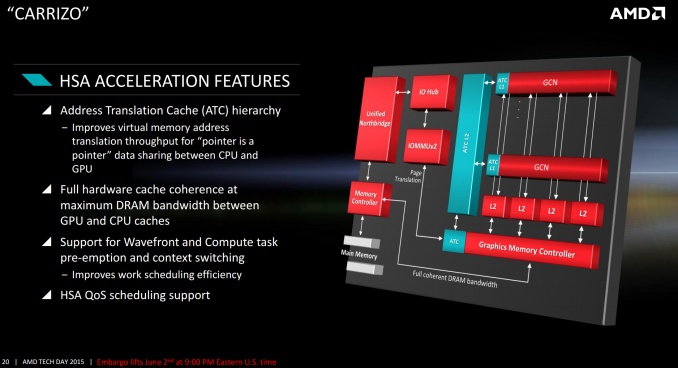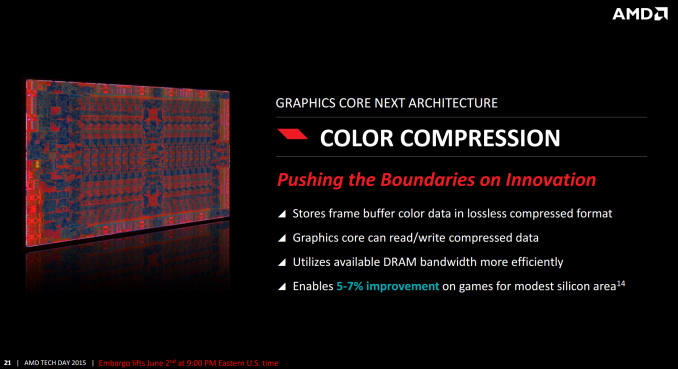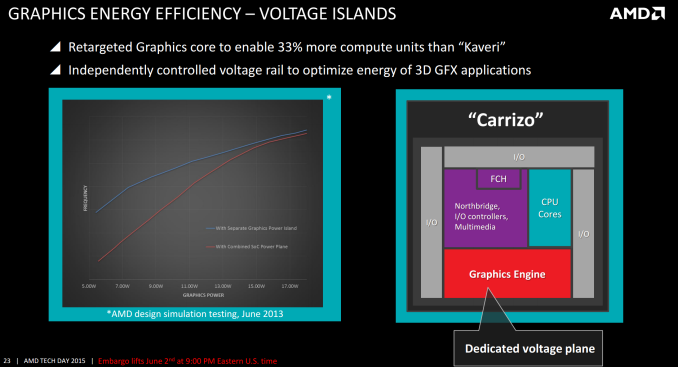AMD Launches Carrizo: The Laptop Leap of Efficiency and Architecture Updates
by Ian Cutress on June 2, 2015 9:00 PM ESTGraphics
The big upgrade in graphics for Carrizo is that the maximum number of compute units for a 15W mobile APU moves up from six (384 SPs) to eight (512 SPs), affording a 33% potential improvement. This means that the high end A10 Carrizo mobile APUs will align with the A10 Kaveri desktop APUs, although the desktop APUs will use 6x the power. Carrizo also moves to AMD’s third generation of Graphics Core Next, meaning GCN 1.2 and similar to Tonga based retail graphics cards (the R9 285).
This gives DirectX 12 support, but one of AMD’s aims with Carrizo is full HSA 1.0 support. Earlier this year when AMD first released proper Carrizo details, we were told that Carrizo will support the full HSA 1.0 draft as it currently stands as it has not been ratified, and they will not push back the launch of Carrizo until that happens. So there is a chance that Carrizo will not be certified has a fully HSA 1.0 compliant APU, but very few people are predicting major changes to the specification at this point before ratification that requires hardware adjustments.
The difference between Kaveri’s ‘HSA Ready’ and Carrizo’s ‘HSA Final’ nomenclature comes down to one main feature – context switching. Kaveri can do everything Carrizo can do, apart from this. Context switching allows the HSA device to switch between work asynchronously while it waits on the other part that needs to finish. I would imagine that if Kaveri came across work that required this, it would sit there idle waiting for work to finish before continuing, which means that Carrizo would be faster in this regard.
One of the key parts of HSA is pointer translation, allowing both the CPU and GPU to access the same memory despite their different interpretations of how the memory in the system is configured. One of the features on Carrizo will be the use of address translation caches inside the GPU, essentially keeping a record of which address points to which data and when an address is in a lower cache, that data can be accessed quicker. These ATC L1/L2 caches will be inside the compute units themselves as well as the GPU memory controller and an overriding ATC L2 beyond the regular L2 per compute unit.
Use of GCN 1.2 means that AMD can use their latest color compression algorithms with little effort – it takes a little more die area to implement (of which Excavator has more to play with than Kaveri), but affords performance improvements particularly in gaming. The texture data is stored losslessly to maintain visual fidelity, and move between graphics cores in this compressed state.
In yet more effort to suction power out of the system, the GPU will have its own dedicated voltage plane as part of the system, rather than a separate voltage island requiring its own power delivery mechanism as before. AMD’s latest numbers on the improvements here only date back to June 2013 via internal simulations, rather than an actual direct comparison.
All the performance metrics rolled in, and AMD is quoting a 65% performance improvement at 15W compared to Kaveri. The adjustment in design is allowing higher frequency for the same power, combined with the additional compute units and other enhancements for the overall score. At 35W the gain is less pronounced, but more akin to regular generational improvements anyway. What we see at 35W is what we would normally expect, and it pales in comparison to the 15W numbers.















137 Comments
View All Comments
D. Lister - Wednesday, June 3, 2015 - link
Calling an unlaunched product "bad" would be just as imprudent as calling it "good", but then what do I know, fortune-telling could be just another one of your super powers, along with mind-reading.Gigaplex - Thursday, June 4, 2015 - link
Why would they use an Intel chip to fake a bar graph? Just put fake numbers directly into a spread sheet, job done.Dirty_Punk - Wednesday, June 3, 2015 - link
Unfortunatelly, time to market, as always for AMD, will be probably 6 month or more... at that time there will be something better from intel. It seems a lot like Asus from this point of view, grat product and very bad supply chain.AMD has 3 problems ritght now:
1- with 28nm is difficult to compete against 14nm of intel
2- very slow from project design to mass production
3- no support from OEM and major system builders (HP & co.), as it seems always that Intel works to force system builder to forget about AMD like years ago...
jabber - Wednesday, June 3, 2015 - link
Yep this time next year when you walk into a PC store you'll still see 25 Intel laptops and one cheap nasty AMD laptop on the shelves. OEMs don't care about AMD anymore. From what I see from customers is, that they only buy AMD if they are the cheapest machine in the shop. And then its a E1 chip and the customer really regrets it.haukionkannel - Wednesday, June 3, 2015 - link
That problem 1 is the worst! AMD APUs are ok, but 28nm vs Intel 14nm is just a huge deal. When considering power and efficiency and how much they can put on the chip.jimjamjamie - Wednesday, June 3, 2015 - link
HP is actually pretty good for offering a good selection of AMD-powered laptops, usually the cheaper models. Better than most other OEMs though.bloodypulp - Wednesday, June 3, 2015 - link
The only decent laptops HP makes are the Elitebooks. And you will pay through the nose for them when you can get better quality from other brands for less. HP should just stop making PCs, period.UtilityMax - Wednesday, June 3, 2015 - link
HP has several models with AMD chips. It's one of them few laptop makers that allows you to configure an Envy laptop with say a 1080p screen, SSD, a A10 CPU, plus discrete graphics.jabber - Thursday, June 4, 2015 - link
And I bet they sell about 8 of those AMD based machines a year.watzupken - Thursday, June 11, 2015 - link
Point 2 is probably their killer to be honest. Point 1 is definitely puts AMD in a disadvantage, but considering that Intel don't seem to be interested in pushing performance since its Sandy Bridge days, it's giving AMD a chance to catch up in terms of performance.To be honest, I think I have to take my hat off AMD's efforts. At 28nm, they are forced to be as creative as they can to squeeze performance out, while keeping power requirements in check.